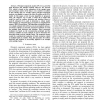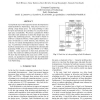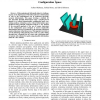48 search results - page 2 / 10 » Fast Pruning Using Principal Components |
AMCS
2008
13 years 5 months ago
2008
Principal component analysis (PCA) is a powerful fault detection and isolation method. However, the classical PCA which is based on the estimation of the sample mean and covariance...
ICIP
2002
IEEE
14 years 6 months ago
2002
IEEE
We present a hybrid and parallel system based on artificial neural networks for a face invariant classifier and general pattern recognition problems. A set of face features is ext...
FPL
2007
Springer
13 years 11 months ago
2007
Springer
An important step in Heterogeneous System Development is Hardware/Software Partitioning. This process involves exploring a huge design space. By using profiling to select hot-spo...
IJCV
2008
13 years 5 months ago
2008
For software and more illustrations: http://www.psi.utoronto.ca/anitha/fastTCA.htm Dimensionality reduction techniques such as principal component analysis and factor analysis are...
ICRA
2010
IEEE
13 years 3 months ago
2010
IEEE
Abstract-- Motion planning of deformable objects is challenging due to the high degrees-of-freedom inherent in deformation as well as the computational cost of producing physically...



